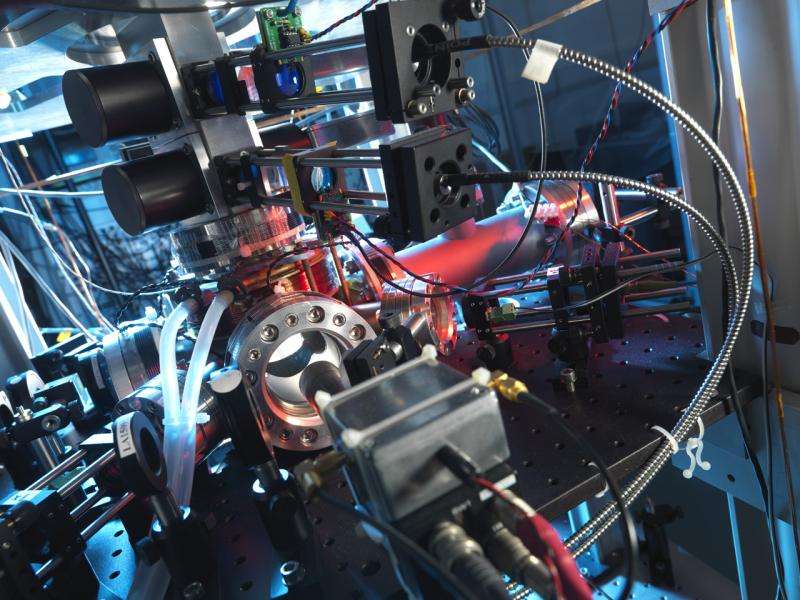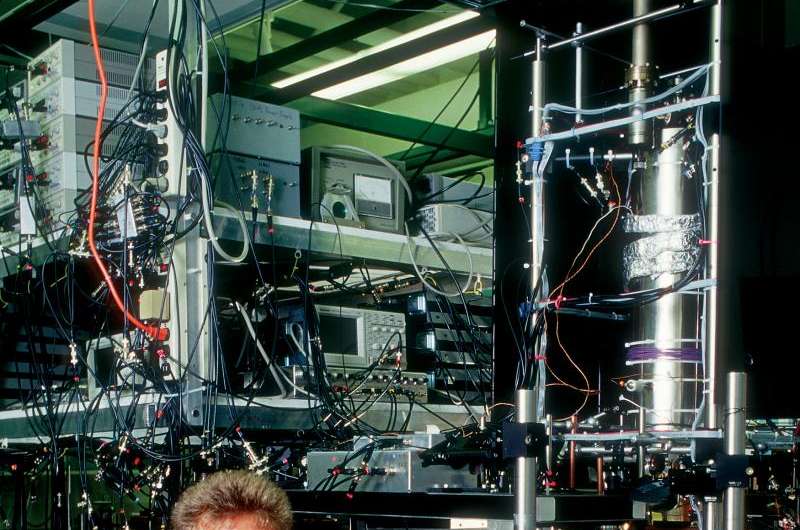The challenge of building a better atomic clock and why it matters

Prior to the mid-18th century, it was tough to be a sailor. If your voyage required east-west travel, you couldn't set out to a specific destination and have any real hope of finding it efficiently.
At the time sailors had no reliable method for measuring longitude, the coordinates that measure a point's east-west position on the globe. To find longitude, you need to know the time in two places—the ship you're on, and the port you departed from. By calculating the difference between those times, sailors got a rough estimate of their position. The problem: The clocks back then just couldn't keep time that well. They lost their home port's time almost immediately after departing.
Today, time is just as important to navigation, only instead of calculating positioning with margins of errors measured in miles and leagues, we have GPS systems that are accurate within meters. And instead of springs and gears, our best timepieces rely on cesium atoms and lasers.
But given the history, it's fitting that scientists like Clayton Simien, a National Science Foundation (NSF)-funded physicist at the University of Alabama at Birmingham who works on atomic clocks, was inspired by the story of John Harrison, an English watchmaker who toiled in the 1700s to come up with the first compact marine chronometer. This device marked the beginning of the end for the "longitude problem" that had plagued sailors for centuries.
"If you want to measure distances well, you really need an accurate clock," Simien said.
Despite the massive leaps navigation technology has made since Harrison's time, scientists—many NSF-funded—are looking for new ways to make clocks more accurate, diminishing any variables that might distort precise timekeeping. Some, for example, are looking for ways to better synchronize atomic clocks on earth with GPS satellites in orbit, where atmospheric distortion can limit signal accuracy to degrees that seem minute, but are profound for the precise computer systems that govern modern navigation.
The National Institute of Standards and Technology, Department of Defense, join NSF in the search for even better atomic clocks. But today's research isn't just about building a more accurate timepiece. It's about foundational science that has other ramifications.
'One Mississippi,' or ~9 billion atom oscillations
Atomic clocks precisely measure the ticks of atoms, essentially tossing cesium atoms upward, much like a fountain. Laser-beam photons "cool down" the atoms to very low temperatures, so the atoms can transfer back and forth between a ground state and an excited state.
The trick to this process is finding just the right frequency to move directly between the two states and overcome Doppler shifts that distort rhythm. (Doppler shifts are increases or decreases in wave frequency as the waves move closer or further away—much like the way a siren's sound changes depending on its distance.)
Laser improvements have helped scientists control atoms better and address the Doppler issue. In fact, lasers helped to facilitate something known as an optical lattice, which can layer atoms into "egg cartons" to immobilize them, helping to eliminate Doppler shifts altogether.
That shift between ground state and excited state (better known as the atomic transition frequency) yields something equivalent to the official definition of a second: 9,192,631,770 cycles of the radiation that gets a cesium atom to vibrate between those two energy states. Today's atomic clocks mostly still use cesium.
NSF-funded physicist Kurt Gibble, of Pennsylvania State University, has an international reputation for assessing accuracy and improving atomic clocks, including some of the most accurate ones in the world: the cesium clocks at the United Kingdom's National Physical Laboratory and the Observatory of Paris in France.
But accurate as those are, Gibble says the biggest advance in atomic clocks will be a move from current-generation microwave frequency clocks—the only kind currently in operation—to optical frequency clocks.
The difference between the two types of clocks lies in the frequencies they use to measure the signals their atoms' electrons emit when they change energy levels. The microwave technology keeps reliable time, but optical clocks offer significant improvements. According to Gibble, they're so accurate they would lose less than a second over the lifetime of the universe, or 13.8 billion years.

Despite that promise of more accurate performance, the optical frequency clocks don't currently keep time.
"So far, optical standards don't run for long enough to keep time," Gibble said. "But they will soon."
Optical frequency clocks operate on a significantly higher frequency than the microwave ones, which is why many researchers are exploring their potential with new alkaline rare earth elements, such as ytterbium, strontium and gadolinium.
"The higher frequency makes it a lot easier to be more accurate," Gibble said.
Gibble is starting work on another promising elemental candidate: cadmium. Simien, whose research employs gadolinium, has focused on minimizing—or eliminating if possible—key issues that limit accuracy.
"Nowadays, the biggest obstacle, in my opinion is the black body radiation shift," Simien said. "The black body radiation shift is a symptomatic effect. We live in a thermal environment, meaning its temperature fluctuates. Even back in the day, a mechanical clock had pieces that would heat up and expand or cool down and contract.
"A clock's accuracy varied with its environment. Today's system is no longer mechanical and has better technology, but it is still susceptible to a thermal environment's effects. Gadolinium is predicted to have a significantly reduced black body relationship compared to other elements implemented and being proposed as new frequency standards."
While Simien and Gibble agree that optical frequency research represents the next generation of atomic clocks, they recognize that most people don't really care if the Big Bang happened 13 billion years ago or 13 billion years ago plus one second.
"It's important to understand that one more digit of accuracy is not always just fine tuning something that is probably already good enough," said John Gillaspy, an NSF program director who reviews funding for atomic clock research for the agency's physics division. "Extremely high accuracy can sometimes mean a qualitative breakthrough which provides the first insight into an entirely new realm of understanding—a revolution in science."
Gillaspy cited the example of American physicist Willis Lamb, who in the middle of the last century measured a tiny frequency shift that led theorists to reformulate physics as we know it, and earned him a Nobel Prize. While research to improve atomic clocks is sometimes dismissed as trying to make ultra-precise clocks even more precise, the scientists working in the field know their work could potentially change the world in profound, unexpected ways.
"Who knows when the next breakthrough will come, and whether it will be in the first digit or the 10th?" Gillaspy continued. "Unfortunately, most people cannot appreciate why more accuracy matters."
From Wall Street to 'Interstellar'
Atomic clock researchers point to GPS as the most visible application of the basic science they study, but it's only one of this foundational work's potential benefits.
Many physicists expect it to provide insight that will illuminate our understanding of fundamental physics and general relativity. They say new discoveries will also advance quantum computing, sensor development and other sensitive instrumentation that requires clever design to resist natural forces like gravity, magnetic and electrical fields, temperature and motion.
The research also has implications beyond the scientific world. Financial analysts worry that worldwide markets could lose millions due to ill-synchronized clocks.
On June 30 th at 7:59:59 p.m. EDT, the world adds what is known as a "leap second" to keep solar time within 1 second of atomic time. History has shown, however, that this adjustment to clocks around the world is often done incorrectly. Many major financial markets are taking steps ranging from advising firms on how to deal with the adjustment to curtailing after-hours trading that would occur when the change takes place.
Gibble says the goal of moving to ever more accurate clocks isn't to more precisely measure time over a long period.
"It's the importance of being able to measure small time differences."
GPS technology, for example, looks at the difference of the propagation of light from multiple satellites. To provide location information, several GPS satellites send out signals at the speed of light—or one foot per nanosecond—saying where they are and what time they made their transmissions.
"Your GPS receiver gets the signals and looks at the time differences of the signals—when they arrive compared to when they said they left," Gibble said. "If you want to know where you are to a couple of feet, you need to have timing to a nanosecond—a billionth of a second."
In fact, he said, if you want that system to continue to accurately operate for a day, or for weeks, you need timing significantly better than that. Getting a GPS to guide us in deserts, tropical forests, oceans and other areas where roads aren't around to help as markers along the way—one needs clocks with nanosecond precision in GPS satellites to keep us from getting lost.
And if you're not traveling to those locales, then there's still the future to think about.
"Remember the movie 'Interstellar,'" Simien said. "There is someone on a spaceship far away, and Matthew McConaughey is on a planet in a strong gravitational field. He experiences reality in terms of hours, but the other individual back on the space craft experiences years. That's general relativity. Atomic clocks can test this kind of fundamental theory and its various applications that make for fascinating science, and as you can see, they also expand our lives."
Provided by National Science Foundation



















